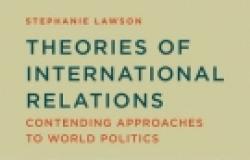Book Review: Theories of International Relations: Contending Approaches to World Politics

Theories of International Relations: Contending Approaches to World Politics by Stephanie Lawson. Cambridge: Polity, 2015. 288 pp., £55.00 / €68.80 hardcover 978-0-7456-6423-1, £17.99 / €22.50 paperback 978-0-7456-6424-8
Theories of International Relations: Contending Approaches to World Politics is a compelling analysis of theoretical foundations in the study of international relations. It emphasizes the importance of bringing together theoretical foundations with substantive matters existing all around us in everyday world politics. Now roughly a century old, the field of International Relations (IR) has been and is interlinked with numerous other disciplines in the social sciences, allowing us to interpret today’s multipolar world and pluralistic societies in unique ways.
Stephanie Lawson, Professor of Politics and International Relations at Macquarie University, reminds readers that while “theorizing is indeed a mental process rather than a physical action or event, it is intimately related to practice” (p. 1). This is an important point and one that is prevalent throughout the book. Equally important, as Lawson explains, is avoiding “‘the abstract’ [being] set up in opposition to ‘the real’” (p. 1). Thus, one cannot forget the fine connections between IR theorizing and real world events and the complex exchange observed but sometimes overlooked between the theoretical and substantive. Lawson’s book is the product of many years of experience in the fields of politics and IR: accordingly, she presents an authoritative account of issues and topics that are inescapable.
Each chapter of the book addresses a different set of IR theories and approaches, and incorporates a historical account, showing how IR theories have developed over the past few decades. “The examination of each of the main IR theories,” Lawson explains, “has also shown that they are largely derivative, taking their cue from political theory more generally, with elements of social theory and economic theory adding additional insights” (p. 246). Lawson clearly illustrates how one discipline interacts with others, while also demonstrating that IR theory is indeed a matter of normative thinking. “Even realism,” she notes, “which purports to eschew normative theorizing, is attuned to themes of tragedy in political affairs, thereby indicating a clear normative sensitivity” (p. 247).
This book is divided into eleven chapters, including an introduction and conclusion. Chapter 1 introduces readers to the intellectual enterprise of engaging with IR theory and the preliminary, yet critical, steps anyone would have to take in order to navigate the tricky and complicated subfield of IR. Accordingly, the author begins with an investigation of theory, norms, and methods. Following this, she presents a discussion of recurrent and emerging epistemological and ontological foundations that one might encounter. What is IR theory? What does it have to do with the rise of states? How do we use IR theory to read such issues as modernity and the sovereign or national state? These questions provide the basis of a highly informative introduction.
Chapters 2 – 5 provide one of the main foundations of the book in the form of the “traditional” IR theories that for so long have dominated and come to define IR theory and the character of IR practice. Classical Realism’s historical accounts of the world come in the form of Thucydides and Machiavelli, Carr and Aron, Niebuhr, Morgenthau, and Herz, and their responses to the circumstances of their time – “from widespread political instability to outright civil war or interstate warfare, with the threat of nuclear annihilation adding a further dimension to the problem of intergroup violence in the twentieth century” (p. 49). From there, Lawson steps into the world of the so-called “Scientific Turn,” with the foundations of Neorealism, Neoclassical Realism, and even Critical Realism. The foundations of liberal thought, its origins, its relationship with Evolutionary Theory, and the search for perpetual peace, are shown to have a distinct relationship with the strains of warfare that were and continue to be profound traits of the world.
In Chapter 6, the key aspects of Marx and his ideas are explained, particularly those associated with the rise and fall of communism in the Soviet Union and communism elsewhere, like China. As Lawson writes, “these perspectives, along with increasing attention to the methodological tools of historical sociology, have exposed some of the limitations of traditional IR theory in both its liberal and realist manifestations” (p. 143). From this point, the book turns to alternative theories including those deemed “radical” by proponents of traditional theoretical approaches. Through Marxist theory, Lawson shows that the English School and Constructivism display inadequacies in understanding world events, structures, actions, and norms. Subsequently, the Postmodern and Poststructuralist turn that emerged through movements of the 1970s is explored. Readers are exposed immediately to the contradictions that are often taken for granted in IR given that defining postmodernism “reflects exactly the kind of rationality that postmodernism sets out to challenge” (p. 160).
As one would expect, it would be difficult to present the many approaches of IR without beginning with the discipline’s pillar theories. However, even in spite of placing these ahead of other theories, which provides an appropriate and logical basis for subsequent discussions of IR theory, Lawson has given equitable focus to each approach. This is no easy task, but Lawson has written knowledgably and critically on a wide spectrum of approaches with remarkable brevity. Indeed, all approaches are important in their own right, but this point raises a curious observation: why is the English School merely lumped into a category called “Social Theories of IR?” Surely, after the extensive toil that eventually led to the English School being accepted as an IR approach in its own right, there would be a greater respect paid to its current position in the discipline. This is even more the case given the context of today’s world politics and the multipolarity leading to a much more complex and intertwined system. Another curious absence in this section is the English School’s relationship with Realism, which is indeed unique and offers up a number of shared positions that often go either ignored or unnoticed.
Constructivism and the depiction of Postmodern/Poststructuralist Turn in IR within this book will easily attract readers’ attention for the beguiling exchange between the ideas of such theorists as Jean Baudrillard, Christopher Norris, and Terry Eagleton, among others, and their views about critique and the interpretation of events. Lawson cites Pierre Bourdieu: “[t]he theory of knowledge is a dimension of political theory because the specifically symbolic power to impose the principles of the construction of reality – in particular, social reality, is a major dimension of political power” (p. 166). The example of Saddam Hussein’s invasion of Kuwait in August 1990 is used to illustrate the political opportunities attached to events that can be socially sculpted, and with meaning consequently converted into sources of power. Lawson has produced an overview of social theory approaches quite impartially, which discusses them somewhat differently from traditional approaches without being unfairly dismissive of their analytical weight. Indeed, she very neatly and commendably portrays the meta-theoreticalness of such approaches as Constructivism as encompassing an array of perspectives, understandings, and attitudes to the world and its tangible and intangible elements: which is no simple task.
Although it is difficult to satisfy everyone in terms of mentioning notable contributors, Lawson has navigated this issue skillfully. Most importantly, the theoretical approaches discussed in this work are shown to have significant value and to have made and continue to make significant contributions to fields of scholarly inquiry because of the real world issues provided as cases/examples. The book is made accessible in terms of its clear language and is aptly partitioned with guiding subheadings, but also through its “further reading” sections, “questions for revision,” case studies, and “key quotes” sections that make this book a very useful tool of instruction. A rich selection of case studies straddle many different temporal periods, providing insight into historical and contemporary applications of approaches like Green Theory – the emergence of environmentalism, Green Political Theory, and Eco-Authoritarianism and Eco-Anarchism. These are precisely the qualities that one would hope to find in such a book, which therefore lends itself readily to undergraduate and graduate students, as well as instructors looking for a concise, easily accessible, and authoritative account of the core theories and approaches in the field of IR.
Scott Nicholas Romaniuk is a PhD Candidate in International Studies (University of Trento). His research focuses on asymmetric warfare, counterterrorism, international security, and the use of force. E-Mail: scott.romaniuk@unitn.it.


